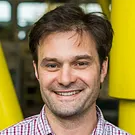Cambiar idioma :
Rodamientos lineales de precisión para la impresora 3D XXL de alto rendimiento para fachadas de viviendas

drylin® Los pórticos del eje E para guiar el cabezal de impresión permiten altas velocidades de impresión
¿Una casa a partir de una impresora 3D? Esto ya no es una utopía. La fachada del edificio holandés "Europe", en el barrio marino de Ámsterdam, se construyó parcialmente de este modo. La idea partió del estudio de arquitectura DUS, que también proporciona una impresora 3D móvil para este tipo de trabajos. Para la producción de los elementos de la fachada, los arquitectos utilizaron tanto nuestros sistemas de pórtico como nuestro soporte de ingeniería.
Consultas
Estaré encantado de responder a sus preguntas personalmente

Borisenko Martin
Distribuidor
Escribir un correo electrónicoConsultas y envíos
En persona:
De lunes a viernes de 8:00 a 18:00h
Online:
24h



